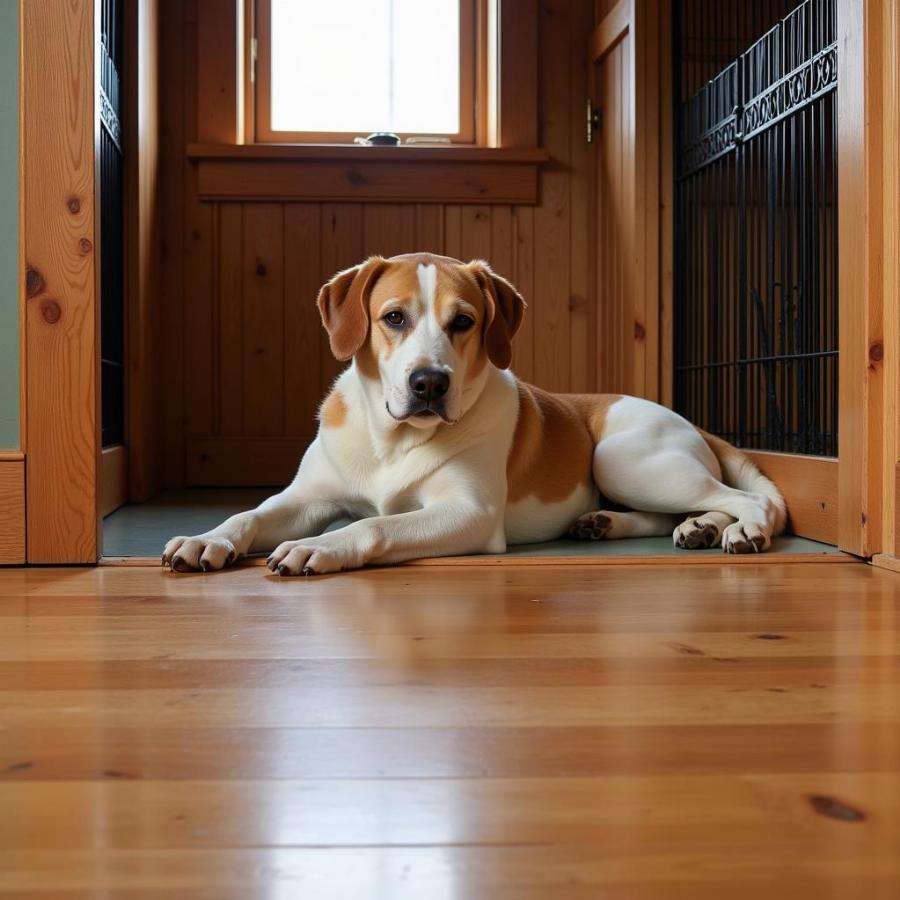Choosing the right flooring for your dog’s kennel is about more than just aesthetics; it’s a crucial aspect of providing a safe, hygienic, and comfortable environment for your furry friend. From concrete to rubber mats and everything in between, navigating the world of dog kennel flooring can feel overwhelming. Fear not, fellow dog lovers! This comprehensive guide is here to equip you with all the information you need to make the best choice for your canine companion.
Factors to Consider When Choosing Dog Kennel Flooring
Before we dive into specific flooring options, let’s explore the key factors you should consider:
- Durability: Your dog’s kennel flooring should withstand scratches, digging, chewing, and the test of time.
- Comfort: Think about cushioning and insulation to keep your dog warm in the winter and cool in the summer.
- Cleanliness: Opt for materials that are easy to clean, resistant to odor absorption, and don’t harbor bacteria.
- Safety: Choose non-slip surfaces to prevent accidents and injuries, especially for older dogs or puppies still finding their footing.
- Drainage: If your dog spends time outdoors, good drainage is essential to prevent waterlogging and mud.
Popular Dog Kennel Flooring Options: A Detailed Look
Let’s break down some of the most popular dog kennel flooring choices, weighing their pros and cons:
1. Concrete Flooring: The Sturdy Foundation
Concrete is a popular choice for its durability and ease of cleaning. It’s ideal for outdoor kennels and can be hosed down or disinfected easily. However, concrete can be hard and cold, so consider adding rubber mats or bedding for comfort.
2. Rubber Flooring: Cushioning and Traction
Rubber flooring, in the form of mats or interlocking tiles, offers excellent cushioning and slip resistance. It’s also relatively easy to clean and comes in various thicknesses and textures. Rubber is a great option for both indoor and outdoor kennels.
3. Epoxy Flooring: Seamless and Durable
Epoxy flooring is a durable, seamless option that’s resistant to stains, moisture, and bacteria. It’s a popular choice for indoor kennels and can be customized with different colors and finishes. However, epoxy can be slippery when wet, so consider adding non-slip additives or mats.
4. Wood Flooring: Classic and Comfortable
Wood provides a naturally warm and comfortable surface for your dog’s kennel. Choose hardwoods like cedar or pine for their natural insect-repelling properties. However, wood requires regular sealing or staining to protect it from moisture and wear and tear.
 Wooden Dog Kennel Floor
Wooden Dog Kennel Floor
5. Plastic Flooring: Affordable and Versatile
Plastic flooring, often in the form of interlocking tiles or kennel trays, is an affordable and easy-to-clean option. It’s relatively durable and comes in various designs and colors. However, some dogs might find plastic slippery or try to chew on the edges.
Maintaining Your Dog Kennel Flooring: Tips for Long-Lasting Cleanliness
No matter which flooring you choose, proper maintenance is crucial for hygiene and longevity:
- Regular Cleaning: Sweep, vacuum, or hose down the kennel flooring regularly to remove dirt, debris, and hair.
- Disinfection: Disinfect the kennel at least once a week with a pet-safe disinfectant to eliminate bacteria and odors.
- Inspection: Regularly inspect the flooring for any signs of damage, like cracks, chips, or loose tiles, and address them promptly.
Frequently Asked Questions about Dog Kennel Flooring
Q: What is the best flooring for an outdoor dog kennel?
A: Concrete and rubber are both excellent choices for outdoor kennels due to their durability and weather resistance.
Q: What kind of flooring is best for puppies?
A: Choose a soft, non-slip surface like rubber or padded mats to provide cushioning and prevent injuries for your playful puppy.
Q: Can I use carpet in a dog kennel?
A: While carpet might seem comfortable, it’s generally not recommended for dog kennels as it can harbor odors, bacteria, and fleas, making it difficult to keep clean.
Q: How often should I replace my dog’s kennel flooring?
A: The lifespan of your dog kennel flooring depends on the material and usage. Inspect it regularly for wear and tear and replace it when necessary to maintain a safe and hygienic environment for your furry friend.
Q: What’s the easiest type of kennel flooring to clean?
A: Concrete, rubber, and epoxy are among the easiest kennel flooring options to clean and disinfect, as they are non-porous and resistant to moisture.
Need More Tail-Wagging Advice?
For more helpful tips on creating a paw-some life for your canine companion, check out these related articles:
Choosing the right dog kennel flooring is a significant step towards ensuring your furry friend’s comfort, safety, and well-being. By considering the factors outlined in this guide, you can create a haven where your canine companion can truly thrive.
About Beaut Dogs:
Beaut Dogs is your one-stop resource for all things dog-related, providing trustworthy and in-depth information about the wonderful world of canines. From breed guides to care tips, we’re here to help you navigate the joys and responsibilities of dog ownership. For personalized advice and support, contact us at [email protected]. Let’s embark on this paw-some journey together!